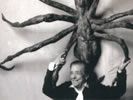Eye For Film >> Movies >> Louise Bourgeois: The Spider, The Mistress And The Tangerine (2008) Film Review
"One thing you learn about Louise is that when she's nervous she gets angry," we are told half way through this documentary about the famous sculptor's life. And Louise is furiously angry. Though she's in her late 90s and growing increasingly frail (she claims to be "light as a feather") she remains a very physical person and sees her work as an intrinsically physical business.
Sculpture requires aggression, she explains, making a violent twisting motion with her hands. She strides through this film like a colossus, her towering personality dominating everything around her, but it's not until close to the end that we discover where some of her aggression and nervousness comes from, and only then do we seem to get close to the core of what her work is about.

Louise is perhaps best known to the general public for her gigantic spider sculptures which dominate certain parks and squares. They're the sort of art that's very much there to communicate with the public, to get them involved and to spark their imaginations. Her gallery pieces do something similar, inviting viewers to explore a maze of intriguing interiors.
Many of them tackle themes of time, love, and family life. Members of her own family are present to give their views on her work and their experiences of living with her, as are some of the friends and allies she has acquired over the years. The Gorilla Girls, dressed in their trademark hairy suits, comment on her importance to the feminist movement, though she does not consider herself to be a feminist - she is an artist first, which she feels is a tremendous privilege and which she therefore has a duty to excel at.
Louise may seem like a dream subject for a documentary, but there's a catch. In dealing with a subject as formidable as this it's difficult to retain much objectivity. The result is a film which is very much about Louise as she sees herself, with a distinct absence of critical distance. This asks a lot of the viewer, as it's left to them to do the questioning if they want to discovers further layers of complexity in her personality and in her work.
Her work, as presented here, remains fascinating. Though much of it is shown only in low lighting, this is consistent with Louise's usual approach to gallery displays, so it retains its proper character. It isn't loud and it isn't trying to speak clearly - it's an intimate sort of art, very personal in nature, knowingly ambiguous. It's perhaps the closest we get here to a truly personal encounter with Louise, except for one standout scene in which she talks about the titular tangerine, recounting an incident of extraordinary cruelty which she suffered at the hands of her father. Moments like this are rare in cinema and it's almost sufficient to justify the remainder of this film's indulgences by itself.
Though not as thorough as it might have been, this remains a sumptuous portrait of a ferociously charismatic woman who has created some remarkable art.
Reviewed on: 22 May 2009
















